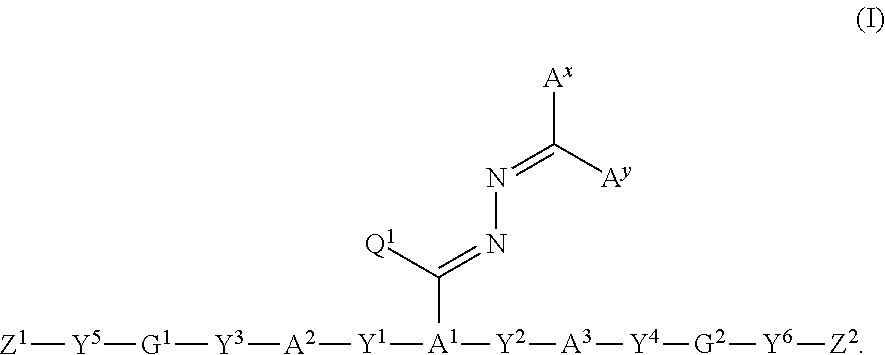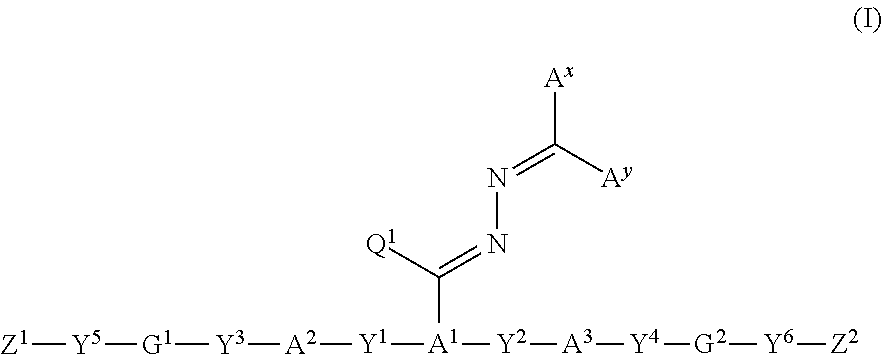Polymerizable compound, polymerizable composition, polymer, and optically anisotropic body
a technology of polymerizable compound and composition, applied in the direction of optical elements, polarising elements, instruments, etc., can solve the problems of low solubility of solvent generally used in industrial processes, narrow range in which liquid crystallinity is obtained, and inability to achieve accurate 14 or 12 retardation over the entire wavelength band. achieve the effect of convenient use, and convenient formation of optical films
- Summary
- Abstract
- Description
- Claims
- Application Information
AI Technical Summary
Benefits of technology
Problems solved by technology
Method used
Image
Examples
example 1
Synthesis of Compound 1
[0199]
Step 1: Synthesis of Intermediate A
[0200]
Intermediate A
[0201]A four-necked reactor equipped with a thermometer was charged with 20 g (144.8 mmol) of 2,5-dihydroxybenzaldehyde, 105.8 g (362.0 mmol) of 4-(6-acryloyl-hex-1-yloxy)benzoic acid (manufactured by DKSH Japan K.K.), 5.3 g (43.4 mmol) of 4-(dimethylamino)pyridine, and 200 ml of N-methylpyrrolidone under a nitrogen stream. After the addition of 83.3 g (434.4 mmol) of 1-ethyl-3-(3-dimethylaminopropyl)carbodiimide hydrochloride (WSC), the mixture was stirred at 25° C. for 12 hours. After completion of the reaction, the reaction mixture was added to 1.5 l of water, and extracted with 500 ml of ethyl acetate. After drying the ethyl acetate layer over anhydrous sodium sulfate, sodium sulfate was filtered off. Ethyl acetate was evaporated from the filtrate under reduced pressure using a rotary evaporator to obtain a light yellow solid. The light yellow solid was purified by silica gel column chromatograph...
example 2
Synthesis of Compound 2
[0209]
Step 1: Synthesis of Intermediate C
[0210]
Intermediate C
[0211]A four-necked reactor equipped with a thermometer was charged with 3.6 g (71.9 mol) of hydrazine monohydrate and 30 ml of ethanol under a nitrogen stream. A solution prepared by dissolving 3 g (14.5 mmol) of 9-anthracene carbaldehyde in 30 ml of THF was slowly added to the solution. The mixture was then stirred at 25° C. for 1.5 hours. After completion of the reaction, the reaction mixture was added to 200 ml of saturated sodium bicarbonate water, and extracted twice with 100 ml of chloroform. The chloroform layer was washed with 200 ml of a saturated sodium chloride solution, and dried over anhydrous sodium sulfate, and sodium sulfate was filtered off. Chloroform was evaporated from the filtrate under reduced pressure using a rotary evaporator, and the resulting solid was dried to obtain 2.5 g of an intermediate C as a yellow solid. The intermediate C was used directly for the subsequent react...
example 3
Synthesis of Compound 3
[0215]
Step 1: Synthesis of Intermediate D
[0216]
Intermediate D
[0217]A four-necked reactor equipped with a thermometer was charged with 4.8 g (95.9 mol) of hydrazine monohydrate and 25 ml of ethanol under a nitrogen stream. A solution prepared by dissolving 3 g (19.2 mmol) of 2-naphthaldehyde in 25 ml of THF was slowly added to the solution, and the mixture was stirred at 25° C. for 2 hours. After completion of the reaction, the reaction mixture was added to 200 ml of saturated sodium bicarbonate water to precipitate a solid. The solid was then filtered off by suction filtration. The solid was then washed with water, and air-dried to obtain 2.5 of an intermediate D as a yellow solid (yield: 76.5%). The intermediate D was used directly for the subsequent reaction without purification.
Step 2: Synthesis of Compound 3
[0218]A four-necked reactor equipped with a thermometer was charged with 3.0 g (4.37 mmol) of the intermediate A synthesized in the step 1 (see Synthes...
PUM
| Property | Measurement | Unit |
|---|---|---|
| boiling point | aaaaa | aaaaa |
| boiling point | aaaaa | aaaaa |
| boiling point | aaaaa | aaaaa |
Abstract
Description
Claims
Application Information
 Login to View More
Login to View More - R&D
- Intellectual Property
- Life Sciences
- Materials
- Tech Scout
- Unparalleled Data Quality
- Higher Quality Content
- 60% Fewer Hallucinations
Browse by: Latest US Patents, China's latest patents, Technical Efficacy Thesaurus, Application Domain, Technology Topic, Popular Technical Reports.
© 2025 PatSnap. All rights reserved.Legal|Privacy policy|Modern Slavery Act Transparency Statement|Sitemap|About US| Contact US: help@patsnap.com



